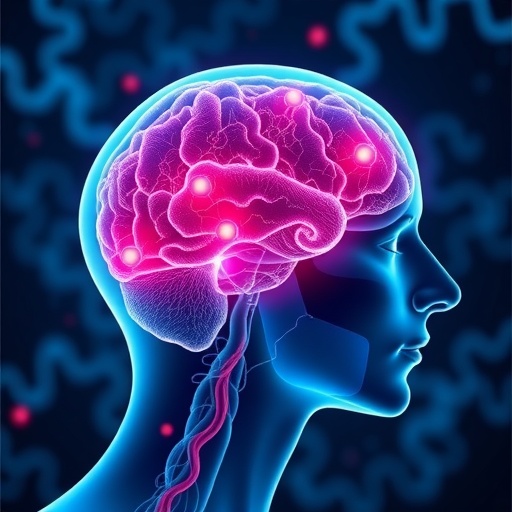A newly published study in npj Parkinson’s Disease unveils a groundbreaking link between urea cycle dysregulation and the progression of neurodegeneration in Parkinson’s disease (PD). This discovery opens a novel metabolic avenue in understanding the mechanistic underpinnings of PD, traditionally viewed primarily as a disorder of dopaminergic neuron loss. By diving deep into cellular metabolism, researchers shed light on how disturbances in nitrogen waste processing might exacerbate neuronal stress, ultimately accelerating neurodegeneration.
The urea cycle, classically described as the liver’s primary biochemical pathway for removing excess nitrogen, converts toxic ammonia into urea for safe excretion. However, multiple lines of evidence now suggest that components of this cycle operate within neuronal cells and glial populations in the brain. Dysregulation of the urea cycle in the central nervous system can lead to the accumulation of nitrogenous waste products, inducing metabolic stress implicated in cellular dysfunction. This study by Zhang, Wan, Qiu, and colleagues expertly maps these metabolic shifts and ties them directly to Parkinsonian pathology.
Parkinson’s disease affects millions worldwide, characterized predominantly by tremors, rigidity, bradykinesia, and postural instability. Its neuropathological hallmark involves the progressive loss of dopaminergic neurons in the substantia nigra pars compacta alongside the presence of abnormal alpha-synuclein aggregates. While genetic mutations and environmental toxins have been investigated extensively, the metabolic disturbances accompanying PD demand further exploration; this work places urea cycle impairment squarely at the metabolic crossroads of neurodegeneration.
.adsslot_Fm2f4ipjrS{ width:728px !important; height:90px !important; }
@media (max-width:1199px) { .adsslot_Fm2f4ipjrS{ width:468px !important; height:60px !important; } }
@media (max-width:767px) { .adsslot_Fm2f4ipjrS{ width:320px !important; height:50px !important; } }
ADVERTISEMENT
The researchers employed an integrative approach, blending metabolomics, transcriptomics, and proteomic profiling from PD patient brain samples alongside in vivo animal models mimicking Parkinsonian neurodegeneration. Quantitative analyses revealed marked alterations in key intermediates of the urea cycle—particularly elevated levels of ornithine and ammonia, concurrent with reduced expression of arginase and carbamoyl phosphate synthetase 1 enzymes. Such imbalances suggest a bottleneck effect impairing nitrogen clearance within affected neurons.
Intriguingly, the study also demonstrates that urea cycle defects trigger a cascade of metabolic consequences, including enhanced oxidative stress, mitochondrial dysfunction, and aberrant energy metabolism. Mitochondria in dopaminergic neurons exhibited decreased respiratory capacity, likely due to elevated ammonia interfering with enzymatic functions essential for ATP synthesis. This metabolic stress creates a vicious cycle by further damaging neuronal infrastructure, thereby accelerating PD progression.
The accumulation of toxic nitrogenous compounds within neurons does not merely serve as a byproduct but appears to directly exacerbate alpha-synuclein aggregation. Experimental models exposed to elevated urea cycle intermediates showed enhanced formation of these pathogenic protein inclusions. This insight provides a mechanistic bridge linking metabolic failure to molecular hallmarks of PD pathology, an area previously not well understood.
Moreover, Zhang et al. provide evidence suggesting that correcting urea cycle dysfunction ameliorates neurodegenerative symptoms in animal models. Pharmacological upregulation of key urea cycle enzymes restored nitrogen homeostasis, reduced oxidative damage, and partially reversed motor deficits. These promising results highlight the urea cycle as a potential therapeutic target, offering hope beyond the current symptomatic treatments that predominantly address dopamine replacement.
The study’s findings also challenge the classical brain-centric view of Parkinson’s disease by implicating systemic metabolic elements. Given that the liver is the canonical site for urea cycle activity, peripheral metabolism might influence central disease phenomena. Exploring the liver–brain axis and interorgan metabolic communication could thus enrich future research on PD etiology and therapy design.
Importantly, this work compels a reevaluation of how metabolic stress integrates with neuroinflammation and immune activation in PD. Elevated ammonia and other metabolites can perturb glial cell function, tipping the balance toward pro-inflammatory states. Neuroinflammation is recognized as a co-conspirator in neuronal death; understanding the metabolic triggers behind inflammatory cascades is crucial for developing comprehensive treatment strategies.
In addition to disease mechanisms, this research underscores the utility of metabolic biomarkers in early PD diagnosis and progression monitoring. Fluctuations in urea cycle intermediates in cerebrospinal fluid or blood samples could provide minimally invasive indicators of disease status, permitting earlier interventions and personalized therapeutic approaches.
Further research is warranted to dissect the precise molecular pathways linking urea cycle alterations with neuronal vulnerability. Identifying upstream modulators of urea cycle enzymes in the nervous system might reveal novel genetic or environmental risk factors contributing to PD. Moreover, expanding metabolic profiling across diverse PD cohorts can elucidate subtype-specific patterns, offering tailored clinical insights.
This discovery also raises questions about potential interactions with known PD-associated mutations, such as those in LRRK2, Parkin, and PINK1, all of which impact mitochondrial function. The intersection of mitochondrial pathways and urea cycle dysregulation could uncover synergistic mechanisms amplifying metabolic stress and neurodegeneration.
The study harnesses cutting-edge mass spectrometry techniques and computational modeling, facilitating a systems biology perspective of PD. This integrative methodology highlights how metabolic networks malfunction in concert rather than isolation, emphasizing the complexity underlying neurodegenerative diseases.
As neurodegeneration transcends singular pathological cascades, recognizing metabolic dysregulation as a critical driver opens new horizons for biomarker discovery and therapeutic intervention. This research exemplifies a paradigm shift, moving beyond neurotransmitter-centric paradigms toward metabolism-centric frameworks that capture the multifactorial nature of Parkinson’s disease.
In sum, the robust findings by Zhang and colleagues compellingly position urea cycle dysregulation as a fundamental contributor to Parkinson’s disease pathology. These insights enrich our molecular understanding and illuminate promising therapeutic avenues, making this study a landmark contribution to neurodegenerative disease research. As the scientific community continues to unravel the intricate web of PD pathogenesis, metabolic pathways such as the urea cycle will undoubtedly remain focal points for innovation and hope.
Subject of Research: Metabolic dysregulation in Parkinson’s disease focusing on urea cycle impairment.
Article Title: Urea cycle dysregulation drives metabolic stress and neurodegeneration in Parkinson’s disease.
Article References:
Zhang, S., Wan, G., Qiu, Y. et al. Urea cycle dysregulation drives metabolic stress and neurodegeneration in Parkinson’s disease. npj Parkinsons Dis. 11, 237 (2025). https://doi.org/10.1038/s41531-025-01099-5
Image Credits: AI Generated
Tags: alpha-synuclein aggregates in Parkinson’sbiochemical pathways in neurodegenerationcentral nervous system metabolismdopaminergic neuron loss in PDmetabolic shifts in brain healthmetabolic stress and cellular dysfunctionneurodegeneration mechanisms in PDnitrogen waste processing in neuronal cellsnovel therapeutic targets for PDParkinson’s disease research findingsParkinson’s disease symptoms and progressionurea cycle dysregulation in Parkinson’s disease





